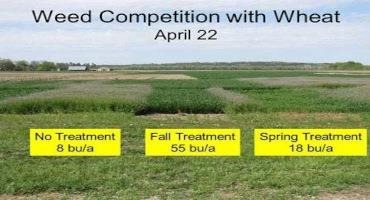By Sarah Lancaster
Too often producers do not notice mustard weeds in their wheat fields until the mustards start to bloom in the spring. As a result, producers often do not think about control until that time. Although it is still possible to get some control at that time with herbicides, mustards are much more difficult to control at that stage and often have already reduced wheat yields by then.
To minimize yield losses, mustards should be controlled by late winter or very early spring, before the stems begin to elongate, or bolt (Figure 1). If mustards are present in the fall, they can be controlled by a variety of active ingredients. You can look for products containing Group 2 herbicides such as chlorsulfuron (Glean, others), metsulfuron (Ally, others), triasulfuron (Amber, others), propoxycarbazone (Olympus, others) or pyroxsulam (PowerFlex, others), and premixes of thifensulfuron plus tribenuron (Affinity and others). Most ALS-inhibiting herbicides control winter annual mustards very well, although there are populations of bushy wall flower (treacle mustard) and flixweed in Kansas that are ALS-resistant and cannot be controlled by these products. Alternative herbicides will be needed to control these populations.
Group 27 herbicides like pyrasulfotole (Huskie) or bicyclopyrone (Talinor) can be used to control ALS-resistant mustards, Other options to control ALS-resistant mustards are Group 4 herbicides like 2,4-D and MCPA. Dicamba and fluroxypyr (Starane, others) are not very effective for mustard control. Quelex, a premix of halauxifen (Group 4) and florasulam (Group 2) is also labeled for mustard control.
Group 27 and Group 4 herbicides have little to no residual activity, thus will only control weeds that have emerged and are actively growing. This means that applying them with fertilizer in January or February when weeds are dormant will not provide good mustard control. application when weeds are dormant may not provide good control. In addition, Special care should be taken to ensure 2,4-D is not applied before wheat is fully tillered to avoid reducing tillering.
In the late winter or early spring, blue mustard is perhaps the most difficult of the winter annual broadleaf weeds to control because it bolts very early. To be effective on blue mustard, herbicides typically need to be applied in late February or early March. Blue mustard is more difficult to control than tansy mustard with 2,4-D because blue mustard has often already bolted by the time 2,4-D can be safely applied to wheat. Thus, 2,4-D often is applied too late to be effective on blue mustard.

Figure 1. Effect of timing of blue mustard control in wheat: K-State research, 2014. Photos by Dallas Peterson, K-State Research and Extension.
Flixweed and tansy mustard should be treated when they are no larger than two to three inches across and two to three inches tall. As these plants become larger, the control decreases dramatically. Ester formulations of 2,4-D and MCPA are more effective on tansy mustard and flixweed than amine formulations. Field pennycress is easier to control than tansy mustard or flixweed. Herbicide applications made before the pennycress bolts are usually effective.
Crop rotation with corn, grain sorghum, soybeans, cotton, or sunflowers is a good way of managing mustards as long as they are controlled in the spring prior to producing seed. Crop rotation will usually result in a gradual reduction of mustard populations in the future as the seedbank in the soil decreases.
Source : ksu.edu